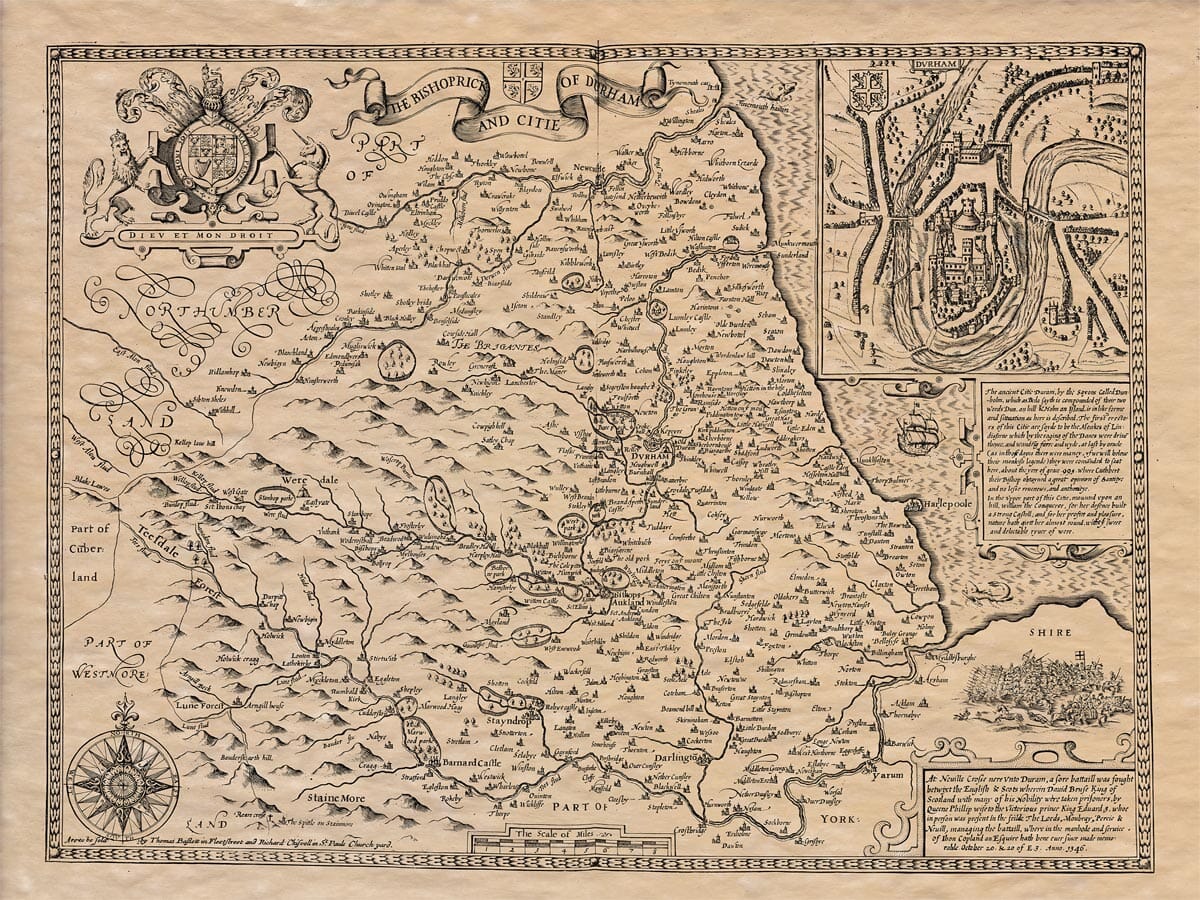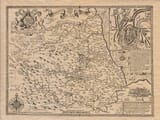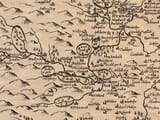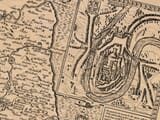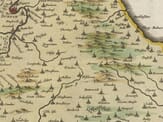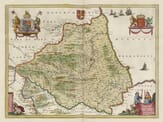Description
Here we have transcribed the text from the historical document titled “The Bishoprick of Durham” featured on the verso of John Speed’s Old Map of Durham
(Book 1, Chap. 42, Page 83):
THE Bishoprick of DURHAM.

THE Bishoprick of Durham containeth those parts and Townships that lie betwixt the River Tees and Derwent, and all along the German Seas. It is neighboured on the North with Northumberland, and their Jurisdictions, parted by the River Derwent: her West is touched by Cumberland, Westmorland, and from Stain-more divided by the River Tees, and by the same water on her South, from Yorkshire even unto the Sea; and the East is altogether coasted by the German Seas.
(2) The form thereof is triangle, and sides not much differing; for from her South-east, unto the West-point, are about thirty miles; from thence to her North-east and Tynemouth, are likewise as many, and her pale along the Sea-shore are twenty three: the whole circumference, about one hundred and three miles.
(3) The air is sharp and very piercing, and would be more, were it not that the vapours from the German-Seas did help much to allay their force and snow: and the store of coals therein growing and gotten, do warm the body, and keep down the cold, which fuel, besides their own use, doth yield great commodities unto this Province, by trade thereof into other parts.
(4) For soil, it consisteth much alike of pastures, arable, and barren grounds: the East is the richest and most champain, the South more mirth, but well inhabited; where all’s rocky, without ether grass or grain, notwithstanding recompenceth her possessor with as great gain, both in rearing up cattle, and bringing forth coal, whereof all this County is plentifully stored, and growth so near to the upper face of the earth, that in the wayes the cart-wheels do turn up the same. Some hold their substance to be a clammy kind of clay, hardened with heat abounding in the earth, and so becoming concocted, is nothing else but Bitumen; for proof whereof, these coals have both the like smell and operation of Bitumen: for being sprinkled with water, they burn more vehemently. But with oyl are quite extinguished and put out.
(5) The ancient Inhabitants known unto Ptolemy, were the Brigantes, of whom we have spoken in the general of Yorkshire, they being subdued by the Romans; after whom the Saxons took in the rest of their Northumberland Kingdom; and at first a Province belonged to the Deirans; and enjoyed by Ella their first King; afterwards invaded by the Danes, and lastly possessed by the Normans: whose steps do so far run unto Scotland, had many times felt their fury, and hath been as a Buckler betwixt them and the English; for which cause the Inhabitants have certain Freedoms, and are not charged with Services as other Counties are, for that both Westmorland, Cumberland, and Northumberland, are not united into Hundreds in those Parliament Rolls whence had the rest; which I must leave for others to supply.
(6) Over this County, the Bishops thereof have had the Royalties of Princes, and the Inhabitants have pleaded privilege not to pass in service over the River of Tees or Tyne (whose charge they have also avowed) was to keep and defend the corps of S. Cuthbert their great and adored Saint, and therefore they termed themselves, The Holy-resolvers. And the people of this Church and his supposed defence against the Scots was such, that our English Kings in great devotion have gone in pilgrimage to visit his Tomb, and have given many large possessions to his Church: such were King Egfrid, Ethelfred, and Guthrun the Dane, Edward, and Athelstan Monarchs of England, and zealous Cnut, the greatest of all, who came thither bare-footed, and at Cuthbert’s Tomb both augmented and confirmed their Liberties. This Saint then, of nothing made Durham become great, and Will. the Conqueror, of a Bishoprick made it a County Palatine: at that time William Carleph, Bishop of the Diocess, pulled down the old Church which Aidan had built, and with sumptuous cost laid the foundations of a new; wherein St. Cuthbert’s Shrine in the vacancy of the Bishops, was the Keeper of the Castle-Keys.
In the West of this Church that’s featured on the old map, is a place called Gallile, the Marble Tomb of Venerable Bede remained, who was born at Jarrow in this County, and became a Monk at Wearmouth, whose painful industries and light of learning in those times of darkness are wonderful, as the volumes which he wrote do well declare. And that the old Monks of England employed their times after his example, their Founders escaped not blame if they did not frustrate, nor the noble foundations so easily overthrown. But the revenge of sin for overlooking the actions of sins, dissolved first the largeness of this Counties liberties, under the reign of King Edward the first, and since that hath taken it piecemeal: places herein erected, under the Reign of K. Henry the eight: such were Durham, Sherburn, Stanydrop, Jarrow, Wearmouth, and Egleton, all which felt the reward of their idleness, and wrath of him that is jealous of his own honour.
(7) Things of rare note observed in this Shire, are the pits of a wonderful depth, commonly called the Hell-Kettles, which are adjoining near unto Darlington, whose waters are remarkably warm. There are thought to be of an Earthquake, which happened in the year of Grace 1179: whereof the Chronicle of Tinmouth maketh mention, whose record is this: “On Christmas day, at Oxenhall in the Territory of Darlington, within the Bishoprick of Durham, the ground heaved up aloft, like unto a high Tower, and continued all day, as it were immoveable, until it came to the height of a man’s sight, with so horrible a noise, that it affrighted the neighbours dwelling there afar off: and the earth suddenly sank down, and made in the same place a deep pit, which is there to be seen for a testimony unto this day.”
(8) Of no less admiration are certain stones lying within the River Were, at Bathe near Durham; from whose sides at the ebb and low water in the Summer, issueth a certain salt reddish water, which with the Sun waxeth white, and growing into a thick substance, becometh a necessity fatal to the use of the by-dwellers.
(9) And places of elder times had in account by the Romans, were Benonivm, now Binchester, and Concarium, (Chester in the street) where their dominions have been dug up, and at Condercum so much, that Egberick Bishop of Durham was therewith made exceedingly rich.
This County hath been strengthened with seven strong Castles, is yet traded with seven Market Towns, and Gods Divine Honour now in hundred and eighteen Parish-Churches celebrated, whose names in the Table featured on the old map are further inserted.

